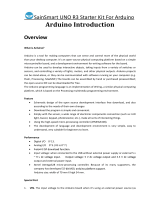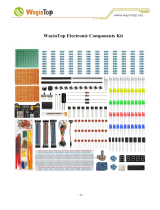
Arduino® is an open-source prototyping platform based on easy-to-use hardware and
software. Arduino® boards are able to read inputs – light-on sensor, a finger on a button or a
Twitter message – and turn it into an output – activating of a motor, turning on an LED,
publishing something online. You can tell your board what to do by sending a set of
instructions to the microcontroller on the board. To do so, you use the Arduino
programming language (based on Wiring) and the Arduino® software IDE (based on
Processing). Additional shields/modules/components are required for reading a twitter
message or publishing online. Surf to www.arduino.cc for more information.
The WPSH338 uses an HM-10 module with Texas Instruments® CC2541 Bluetooth v4.0 BLE
chip, fully compatible with WPB100 UNO. This shield has extended all the digital and
analogue pins out into 3PIN, making it easy to connect to sensors using 3PIN wire.
A switch is provided to switch on/off the HM-10 BLE 4.0 module, and 2 jumpers allow to
select D0 and D1 or D2 and D3 as serial communication port.
• pin header spacing: 2.54 mm
• Bluetooth® chip: Texas Instruments® CC2541
• working frequency: 2.4 GHz ISM band
• modulation method: GFSK (Gaussian Frequency Shift Keying)
• transmission power: -23 dBm, -6 dBm, 0 dBm, 6 dBm, can be modified by AT command
• sensitivity: =-84 dBm at 0.1% BER
• transmission rate: asynchronous 6K bytes
• security: authentication and encryption
• supporting service: central & peripheral UUID FFE0, FFE1
• power consumption: 400-800 µA during standby, 8.5 mA during transmission
• power supply shield: 5 VDC
• power supply HM10: 3.3 VDC
• working temperature: -5 to +65 °C
• dimensions: 54 x 48 x 23 mm








